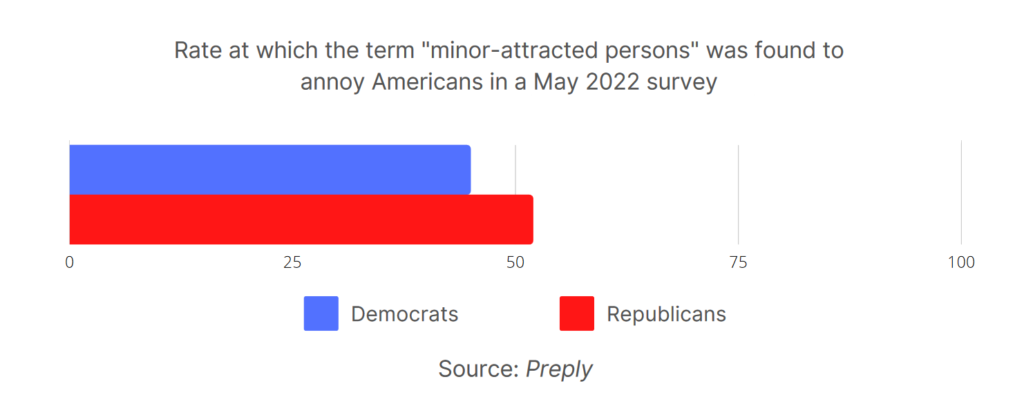As terms like “minor-attracted person” or “MAP” have become more common among researchers, mental health professionals, and abuse prevention organizations, they have also become more contentious in the public discourse. In particular, conservative commentators such as Laura Ingraham and Tucker Carlson have voiced their disapproval of this terminology, while attempting to associate it with the political left, including LGBTQ+ rights movements.
However, according to survey results published this summer by the language learning website Preply, public opinion on this terminology is a near even split, regardless of political affiliation. According to Preply’s article on the results, only 45% of Democrats and 52% of Republicans indicated that the term “annoy[ed] them in practice.” The results are based on a survey of 1,012 Americans conducted in May 2022.
These results differed from other terms in Preply’s category of political or social justice terminology, which tended to be more tolerated by Democrats and less tolerated by Republicans.

Terms like “minor-attracted person” have the advantage of being more value-neutral than alternatives like “pedophile” or “hebephile,” as “pedophilia” carries strongly negative connotations and is often used incorrectly to refer to child sexual abuse. These negative associations can lead to real-world consequences: for example, a 2021 study found that students planning to become social workers were more likely to break client confidentiality and less willing to work with a client described as a “pedophile” than a client described as someone who is “sexually attracted to children, [who has not] committed an offence against a child.” The study authors went on to use the term “minor-attracted people” in their publication.
Additionally, some academic sources fail to distinguish between “pedophilia” and the condition of “pedophilic disorder” as described in the DSM-5, which requires additional factors beyond attraction to children or adolescents to be diagnosed. This confusion can lead to conclusions that are difficult to interpret, or applied to the wrong group of people entirely.
B4U-ACT has preferentially used the term “minor-attracted person” to refer to people who are attracted to children or adolescents since at least 2007. Before that, we had used the term “minor-attracted adults” for this purpose since our founding, before switching to reflect the fact that minor-attracted people usually begin to experience this pattern of attraction before they are adults.
While many researchers now use terms like “minor-attracted person” and “minor-attraction,” others still refer to “pedophilia,” and some have argued in favor of other alternatives, such as “child-attracted persons.” (See Michael Seto’s response to our review of his 2018 AASECT Plenary Talk)
Preply did not immediately respond to a request for more information about their survey.

